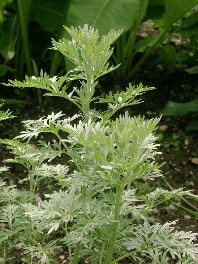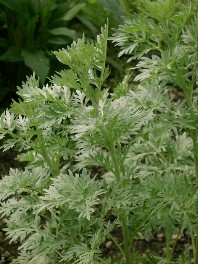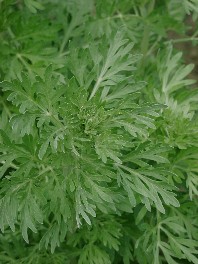 Vermouth is a typical plant for mediterranean countries.
Vermouth is a typical plant for mediterranean countries.
In Central Europe Vermouth is cultivated in gardens, like the monks showed in the middle ages.
The bitter taste of the Vermouth makes it a famous bitter-herb against problems of the digestive system.
In former times Vermouth was used in drinks named Absinth, what was bad for the health of the brain.
Medicinal Uses
- Digestive weakness
- General weakness
- Full of iron
- Blood cleansing
- Flatulences
- Stomach weakness
- Mouth smell
- Gall complaints
- Jaundice
- Kidney weakness
- Circulation strengthening
- Menses forcing
- Earache
- Sprains
- Contusions
- Wounds
Information
| Used Parts: | Leaves |
| Substances: | Bitter essences, essential oil, |
| Time to collect: | June until August |
Methods
 Vermouth can be used as tea or as tincture.
Vermouth can be used as tea or as tincture.
The main use of Vermouth is as a tea.
Tea
To prepare a Vermouth tea pour one cup of boiling water over one or two spoonful of Vermouth.Wait for five up to ten minutes, than filter the tea and drink it slowly.
You can drink one up to three cups of Vermouth tea each day.
Tincture
A tincture of Vermouth can be bought (i.e. in pharmacies) or prepared by yourself.To prepare a Vermouth tincture, fill some Vermouth in a glass. Pour some grain alcohol in the glass, enough to cover the herbs. Close the glass and let it stand at a warm place for two up to six weeks. After the waiting time filter the tincture and pour it into a dark bottle.
Use 10 up to 50 drops of the tincture up to three times daily.
You can use the tincture pure or diluted with water.
Internal use
Vermouth can be used internally against digestive weakness.It also helps against a weak gall bladder.
You can use Vermouth also to ally menstrual pains.
|
Beware!
Vermouth should not be used in pregnacy and when you suffer from stomach ulcer. It shouldn't be used in large doses and for a long time. |
External use
Vermouth tincture or tea can be used external as poultice, in washings or as bath.This can help against contusions and wounds.
Plant description
 Vermouth is at home in Southern Europe.
In the middle ages it was brought to Central Europe by monks.
Vermouth is at home in Southern Europe.
In the middle ages it was brought to Central Europe by monks.
As Vermouth likes stony dry ground beside roads and at stony places.
Vermouth can grow up to one meter high.
It is an perennial plant.
The stem of the Vermouth is woody.
The leaves are tripinnate lobed. Their colour is grey.
From july to september the flowers are blossoming. They are yellow and small with lots of petals.
